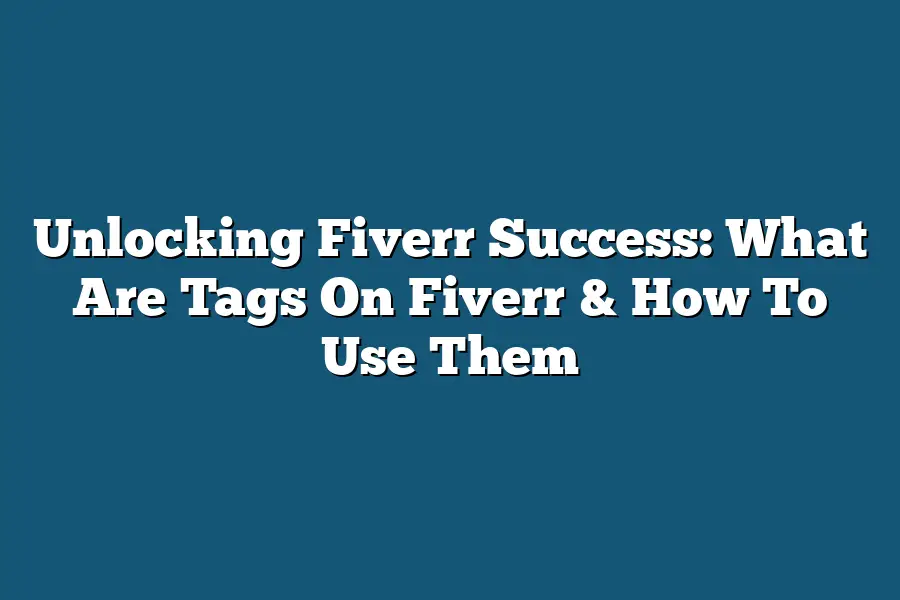Fiverr is a freelance platform where sellers, also known as “gig providers,” offer their skills and services starting at $5 per task. Tags on Fiverr are keywords that help clients find relevant gigs based on specific services or expertise. Sellers can add relevant tags to their gig descriptions to increase visibility and attract more clients. By using a combination of relevant tags, sellers can improve the discoverability of their services and stand out in a crowded market.
As a seasoned Fiverr seller, I’ve learned that unlocking success on this platform requires a deep understanding of one of its most powerful tools: tags.
From primary tags that define your gig’s core service to niche-specific tags that help you stand out from the competition, mastering the art of tag usage is crucial for attracting high-quality clients and maximizing your earnings.
But with so many options available, it can be overwhelming to know where to start.
That’s why I’m excited to share my expertise on how to use Fiverr tags effectively – from researching relevant terms to creating custom categories that drive visibility and conversions.
Whether you’re a newcomer looking to break into the market or an established seller seeking to boost your business, this guide will empower you with the knowledge and strategies needed to take your Fiverr success to the next level.
Table of Contents
What Are Tags On Fiverr?
Hey there, fellow freelancers!
Let’s dive into the wonderful world of Fiverr tags.
As someone who’s struggled to get my gigs noticed in the past (yes, I’ve been there too!), I’m excited to share my insights on what these magic words are and how you can use them to unlock success on Fiverr.
So, what are tags on Fiverr?
In a nutshell, they’re keywords that help clients find your services.
When you create a gig on Fiverr, you get to assign up to 10 tags – primary, secondary, or niche-specific (more on those later).
These tags act as signals to the algorithm, indicating what kind of work you do and who might be interested in your services.
Types of Tags: Primary, Secondary, and Niche-Specific
Now that we know what tags are, let’s break down the different types:
Primary Tags (Up to 3)
Your primary tags should reflect the main service or skill you’re offering.
For instance, if you’re a freelance writer, your primary tag might be “Content Writing.” These tags are crucial because they help Fiverr’s algorithm understand what your gig is about.
Secondary Tags (Up to 2)
Secondary tags provide more context and specificity around your primary services.
Going back to our writer example, their secondary tag could be “Blogging Services” or “Copywriting.” These tags help clients searching for related services find your gig.
Niche-Specific Tags
Niche-specific tags are where things get really interesting!
These tags are specific to a particular industry or market – think “UX Design for E-commerce Sites” or “Social Media Management for Real Estate Agents.” By using these tags, you can attract clients who are searching for services like yours.
Tips for Selecting Relevant and High-Traffic Tags
Now that we’ve covered the basics, let’s get to the good stuff – choosing the right tags!
Here are some actionable tips:
- Research, research, research: Look at your competitors’ gigs (yes, it’s okay to snoop a little!) and see which tags they’re using. You can also use Fiverr’s built-in search feature to discover high-traffic keywords.
- Use long-tail keywords: Instead of targeting broad terms like “Web Development,” try something more specific like “WordPress Plugin Development.” This will help you stand out in a crowded market and attract clients who are searching for exactly what you offer.
- Keep it relevant: Only use tags that accurately describe your services. Don’t be tempted to stuff your gig with irrelevant keywords – it’s not worth the risk of getting penalized or attracting low-quality leads.
In conclusion, Fiverr tags are a powerful tool that can help you boost your visibility and attract high-quality clients.
By understanding what types of tags exist and how to select relevant ones, you’ll be well on your way to unlocking success on Fiverr.
Stay tuned for the next section, where we’ll dive into some advanced strategies for using Fiverr’s tag system to grow your business!
How To Use Tags Effectively On Fiverr
When it comes to unlocking Fiverr success, many freelancers overlook one of the most powerful tools at their disposal: tags.
Yes, those pesky little labels that help clients find your gig can make all the difference between a mediocre and a magnificent career on the platform.
So, how do you use tags effectively on Fiverr?
Let’s dive into my step-by-step guide to finding the perfect ones for your gig:
Using Fiverr’s Tag Suggestions Tool
The first place to start is with Fiverr’s built-in tag suggestions tool.
This nifty feature provides a list of relevant tags based on your gig title, description, and categories.
It’s like having your own personal tag coach!
To access it, simply edit your gig and click on the “Tags” tab.
Scroll down to the “Tag Suggestions” section, and you’ll see a list of pre-populated tags that are relevant to your offering.
Here’s the thing: Fiverr’s algorithm is smart enough to recognize patterns and relationships between tags.
So, by using these suggested tags as a starting point, you can tap into the collective wisdom of the platform’s top-performing gigs in your niche.
Analyzing Top-Performing Gigs In Your Niche
Next up, take some time to analyze the top-performing gigs in your niche.
You can do this by searching for relevant keywords and scrolling through the results.
Take note of the tags that these successful sellers are using.
Are there any common themes or patterns emerging?
What types of services or skills are they highlighting?
By studying the competition, you can identify gaps in the market and opportunities to differentiate yourself with unique tag combinations.
Creating A List Of Relevant And High-Traffic Tags
Now it’s time to get organized!
Take the tags from Fiverr’s suggestions tool, as well as those you’ve discovered through your analysis of top-performing gigs, and create a master list.
Prioritize the most relevant and high-traffic tags for maximum visibility.
Here’s a pro tip: Don’t be afraid to get creative with your tag combinations!
Use keywords that are specific to your niche or service offering, and don’t be afraid to add in some long-tail tags to target specific search queries.
Tips For Organizing And Categorizing Tags
Finally, here are some tips for organizing and categorizing your tags for maximum visibility:
- Categorize Your Tags: Divide your tags into logical categories or sub-tags. This will help clients quickly find your gig when searching for related services.
- Use Consistent Formatting: Use a consistent formatting style throughout your tag list. This will make it easier to scan and identify patterns.
- Prioritize Relevant Tags: Prioritize the most relevant and high-traffic tags at the top of your list, so they’re more likely to be seen by clients searching for related services.
By following these steps and tips, you’ll be well on your way to unlocking Fiverr success with the right tags.
So, what are you waiting for?
Start optimizing those tags today!
Advanced Tag Strategies For Fiverr Success
As a seasoned Fiverr seller, you’re likely familiar with the importance of tags in helping your gigs stand out from the crowd.
But are you using them to their full potential?
In this section, we’ll dive into some advanced tag strategies that can take your Fiverr success to the next level.
Using Long-Tail Keywords To Target Specific Searches
One of the most effective ways to use tags is by targeting specific searches with long-tail keywords.
Think about it – instead of competing for the general term “graphic design,” why not target something like “vector illustration services for e-commerce businesses”?
By using longer, more specific phrases, you’re narrowing down your competition and increasing the chances that potential clients will find your gig when searching for those exact words.
To get started with long-tail keywords, try brainstorming a list of specific search terms related to your niche.
For example, if you offer voice-over services, some long-tail keywords might include “narrator for explainer videos,” “male voice actor for corporate training,” or “female voice talent for podcast intros.” Once you have your list, start incorporating those keywords into your Fiverr tags.
Creating Custom Categories And Subcategories
Another powerful way to use tags is by creating custom categories and subcategories.
This can help organize your gigs in a way that makes sense for both you and your potential clients.
For instance, if you offer social media management services, you might create categories like “social media strategy,” “content creation,” and “engagement optimization.” Within each category, you could have subcategories like “Facebook page management” or “Instagram story ideas.”
By using custom categories and subcategories, you’re making it easier for potential clients to find your gigs and increasing the chances that they’ll be interested in what you offer.
Plus, this can help you stand out from other sellers who might not be as organized.
Utilizing Seasonal And Trending Tags To Capitalize On Current Demand
Finally, don’t forget to keep an eye on seasonal and trending tags!
By incorporating relevant terms into your Fiverr tags, you can capitalize on current demand and attract new clients.
For example, if it’s the holiday season, you might add tags like “Christmas gift ideas” or “New Year’s Eve party planning.” In the summer, you could use tags like “summer wedding planning” or “4th of July fireworks displays.”
To find trending tags, try using tools like Google Trends or social media to see what people are talking about.
You can also check out Fiverr’s own trending tag list or use third-party apps like Tagomatic to help you stay on top of the latest trends.
By incorporating these advanced tag strategies into your Fiverr profile, you’ll be well on your way to unlocking success and attracting new clients.
Remember – it’s all about targeting specific searches, organizing your gigs in a logical way, and capitalizing on current demand.
Happy selling!
Final Thoughts
As I wrap up this deep dive into Fiverr’s mighty tags, I’m reminded that success on the platform requires a thoughtful approach.
By understanding how tags work and selecting the right ones for your gig, you can increase visibility, attract more clients, and boost earnings.
It’s not just about slapping a few keywords onto your listing – it’s about crafting a strategic tag plan that drives results.
In this post, we’ve covered everything from primary to niche-specific tags, as well as advanced strategies for maximizing your tag game.
Now, it’s up to you to put these tips into action and unlock the full potential of Fiverr.
Whether you’re just starting out or looking to level up your freelancing career, I’m confident that with the right tags in place, you’ll be well on your way to achieving your goals.


